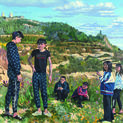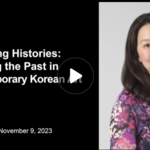
The collection of Asian art includes diverse materials from China, Japan, Korea, Southeast and Central Asia, and India, dating from Neolithic to present times. The strengths of the collection are in Chinese and Japanese art ranging from Neolithic pottery and jade, ancient ritual bronze vessels, ceramics, lacquerware, metalware, and sculpture to woodblock prints, painting, and calligraphy. In the arts of China, the collections of calligraphy and painting rank among the finest outside Asia. Calligraphic works range from Buddhist and Daoist scriptures of the Tang dynasty to poems, records, and letters from the Song dynasty. Among the paintings are rare masterpieces from the Song and Yuan dynasties as well as numerous examples by later masters. The collection also includes Shang dynasty oracle bones, ancient ritual bronze vessels, ceramic vessels and figurines, Buddhist sculpture, and a rare group of Liao or Jin dynasty painted wood tomb panels and coffin boards from the tenth to thirteenth centuries. The Museum has a growing collection of Japanese art, with works ranging from Jōmon to modern period ceramics, Heian and Kamakura period sculpture, as well as painting, calligraphy, screens, and woodblock prints from the Heian to contemporary periods. The arts of Korea include examples of celadon and modern painting and sculpture. Metal, stone, and terracotta sculptures from Southeast Asia, India, Gandhara, and other Central Asian regions make it possible for the visitor to trace Buddhist sculptural styles from early forms to later developments in East Asia. Works from the collection are exhibited in the Asian galleries on a rotating basis throughout the year.
-
Selections from the Princeton University Art Museum's Asian art collection are presented in the Asian Art Website.
The arts of Asia are examined in a cultural and historical context.
-
Explore the P.Y. and Kinmay W. Tang Center for East Asian Art




